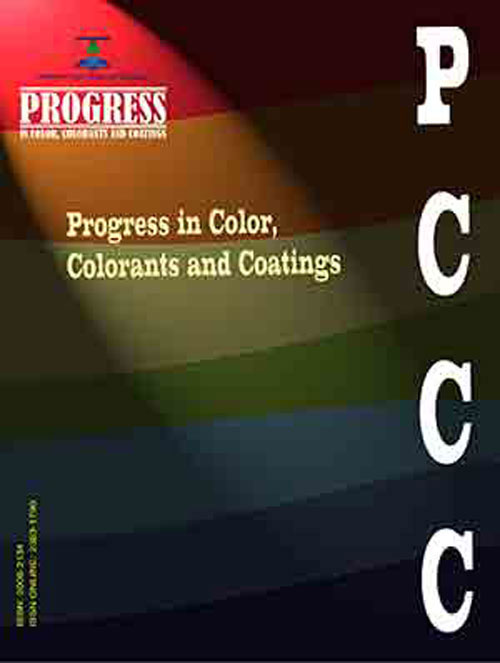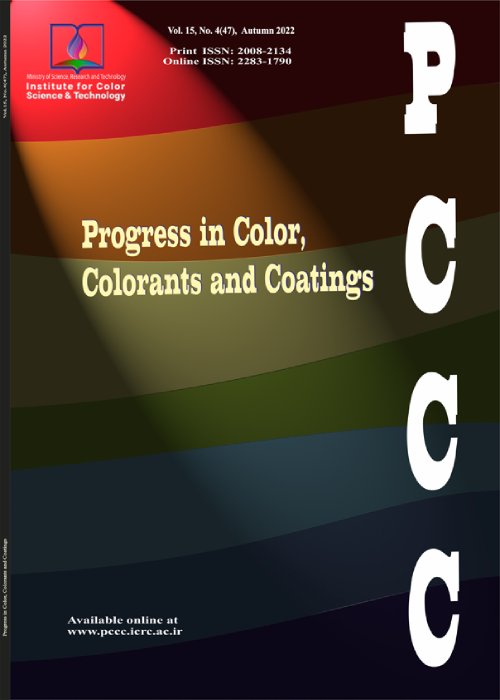فهرست مطالب

Progress in Color, Colorants and Coatings
Volume:15 Issue: 4, Autumn 2022
- تاریخ انتشار: 1401/03/14
- تعداد عناوین: 8
-
-
Pages 269-283SPK NL steel, as a hard and process-wise stable alloy, has myriad applications in sheet metal forming. However, to increase the quality of the products and decrease cost, applying a self-lubricant protective coating on the surface seems to be an efficacious strategy. The CrN and carbon-enriched CrN, i.e. (a-C: CrN), hybrid coatings are physically vapor-deposited on the SPK NL alloy surface. The C/N ratio on the morphology, tribological properties, mechanical characteristics, and anticorrosive features of the coated SPK NL substrates are studied. Results evidenced that high carbon inclusion increases the plastic hardness of the CrN coating up to about 35 GPa and significantly improves the plasticity index to ~0.2. The COF decreases from ~0.6 for CrN to ~0.1 for (a-C:CrN). Coatings with a high sp2 fraction impart an excellent self-lubricant characteristic to SPK NL steel. Electrochemical impedance spectroscopy data approve that both coatings provide high corrosion resistance, and although CrN provides superior corrosion resistance nonetheless. As an outcome, (a-C:CrN) hybrid coatings with high carbon content, possessing high hardness, good tribological properties, and corrosion resistance seems to be a prospective candidate for surface protection of SPK NL steel.Keywords: Surface modification, SPK NL steel, (a-C: CrN), COF, Corrosion Resistance
-
Pages 285-293Natural and synthetic organic compounds were used as corrosion inhibitors to produce coordination complexes with metallic surface utilizing the active sites. These metallic complexes occupy a significant surface area on the metallic surface, therefore coating the metallic surface and shielding the metallic surface from acidic solutions. In the current study, a new Schiff base, namely (3-nitrobenzaldehyde)-4-phenylthiosemicarbazone (3N-4P), was designed and synthesized. The chemical structure of 3N-4P was determined using spectroscopic methods such as infrared (IR) and proton and carbon-13 nuclear magnetic resonance (1H and 13C-NMR) and CHN-analysis. The corrosive inhibitory potential of the 3N-4P was tested on mild steel (MS) coupons in a 1 M HCl utilizing weight loss techniques. The inhibitive efficiency (IE%) of 3N-4P increased with 3N-4P concentration increases and decreased with increasing temperature. The experimental findings revealed that 3N-4P molecules obeyed the Langmuir adsorption isotherm. Scanning by electron microscope (SEM) technology measured the uninhibited and inhibited coupon surface.Keywords: Thiosemicarbazone, Langmuir, Inhibition Efficiency, Corrosion inhibitor, HCl
-
Pages 295-303This work was intended to investigate the effect of various tackifiers (terpene phenolic resin (TPR), rosin ester (RS), and pentaerythritol rosin ester (PERS)) on the main properties of a PSA such as tack, peel, and shear strength. In this experiment, the PSA based on butyl acrylate-vinyl acetate was synthesized. Various characters such as solid content, conversion percentage, viscosity, and particle size were evaluated. Different concentrations of tackifiers were added to the formulation. The results confirm that the RS may be most compatible with the synthesized PSA. In addition, using 7.5 wt % of RS shows a significant change in the tack of the PSA; however, RS causes a sharply declining peel strength from 0.42 to 0.1 N/mm, while by adding TPR (5 wt%) besides PERE (2.5 wt %), the peel strength reaches its maximum level of 1.3 and 1 N/mm, respectively. Surprisingly, increasing the number of tackifiers causes diminished shear strength.Keywords: Pressure-sensitive adhesive, acrylate, tackifier, emulsion, Terpene phenolic resin rosin ester, Pentaerythritol rosin ester
-
Pages 305-318The present study involves a novel approach in manufacturing nano-crystalline dispersions of titanium dioxide, a widely used pigment in the paints and coatings market. These dispersions are developed to provide certain benefits over conventional titanium dioxide powder to improve the coating parameters such as adhesion promotion, hiding, tinting strength, dispersion, and reduced dosage. Dispersions are synthesized using bead mill and high-speed disperser in a unique multi-stage process, thereby developing a scalable technology for industrial synthesis. Characterization of these dispersions, namely XRD, particle size analysis, and FE-SEM, confirmed the presence of nano-crystalline titanium dioxide particles. Moreover, analysis of process variables was also conducted by studying the effect of grinding time on particle-size reduction. Rheological analysis was performed for water and styrene-acrylic copolymer emulsion systems. It was developed a dataset of viscosities. Results of this study can be assessed to create scalable technology for the synthesis of nano-crystalline dispersions, which can be used as a pigment in multipurpose waterborne coating systems.Keywords: Rheological Analysis, Scalable Technology, Titanium Dioxide Nanoparticles, Waterborne Coatings, Pigment Properties
-
Pages 319-326Polymers became Irreplaceable components that enter all industries due to their exceptional properties and low costs. As there are many polymers, the production quantities differ from one type to another depending on the offered characteristics; among them, Poly (vinyl chloride) (PVC) was widely used in many applications. However, it undergoes many harmful changes when exposed to ultraviolet light. This paper concentrates on calculating the photodecomposition rate constant and surface morphology of PVC films before and after filling Tin (IV) complexes (1-3) as photo stabilizers. The photodecomposition rate constant was determined to indicate Tin (IV) complexes' impact on PVC films after 300 h exposure to UV irradiation. The surface morphology of PVC films was investigated by field emission scanning electron microscopy (FE-SEM) and Fourier-transform infrared spectroscopy (FTIR). However, the photodecomposition rate constant was calculated along with the irradiation time up to 300 hours for the plain and modified PVC films. According to the result, organotin compounds and Schiff bases were used as photo stabilizers. In this case, the photodegradation was significantly decreased.Keywords: PVC, photodegradation, UV light, photodecomposition rate constant, organotin(IV) complexes
-
Pages 327-340Two fluorescent reactive dyes based on coumarin-benzimidazole derivatives were synthesized, characterized, and dyed cotton fabric. First, (3-(1H-benzo[d]imidazol-2-yl)-7-(diethylamino)-2H-chromen-2-one) (CB) was reacted with cyanuric chloride to produce primary colorant. Two fluorescent reactive dyes were created by separately substituting sulfanilic acid and nicotinic acid into the original material. The synthesized dyes were characterized by FTIR, 1HNMR, 13CNMR, elemental analysis, and UV-Vis spectroscopy. Both water-soluble dyes exhibited a positive solvatochromism response with considerable fluorescent intensity and quantum yield in photophysical evaluations. The nicotinic acid substituted reactive dye, 3-carboxy-1-(4-chloro-6-(2-(7-(diethylamino)-2-oxo-2H-chromen-3-yl)-1H-benzo [d]imidazol-1-yl)-1,3,5-triazin-2-yl)pyridin-1-ium chloride (D3), showed the highest quantum yield (0.65 in aqueous form) and dyeing exhaustion (83 %) with a maximum emission wavelength of 512 nm when dyed on cotton fabric. High visibility and colorfastness assessments of the dyed fabrics confirmed, D3 could be successfully introduced as the first highly visible coumarin-benzimidazole fluorescent reactive dye for cotton, according to the international standard of high visibility clothing, ISO 20471:2013.Keywords: Coumarin-benzimidazole, fluorescent, Reactive Dyes, High visibility, cotton
-
Pages 341-353
Today, a growing number of the world population faces a rise in the cost of living significantly increased energy costs. That is why Energy-saving has become a vital issue. One of the remarkable ways to reduce energy consumption is using cool pigments; therefore, research has been done to improve pigments' infrared reflection capability. In this paper, the role of particle morphology was investigated to boost the infrared reflection property of iron-chromium-based pigments. For this purpose, a series of inorganic pigments based on the Fe0.7Cr1.3O3 formula was prepared via a hydrothermal method. Surfactants altered the particles' morphology to improve the pigments' reflecting properties. According to the IR reflectance results, flaky particles exhibit an enhanced IR reflection, and they have significantly larger IR reflections than spherical particles. Furthermore, the results have revealed that silica coating leads to a meaningful improvement in the IR reflection property. It was found that the maximum near-infrared solar reflectance of the sample with 2.63 % succinic acid surfactant and silica coating was 52.23 % compared to that of Fe0.7Cr1.3O3, which was 25.36 %.
Keywords: Cool nano pigments, Reflected near-infrared radiation, Surfactant, Morphology, Fe0.7Cr1.3O3, Hydrothermal synthesis -
Pages 355-366
This paper reports the synthesis of spinel manganese aluminates (MnAl2O4) brown pigments via microwave-assisted solution combustion using different urea-glycine fuel mixtures. The synthesized samples were analyzed through all the following methods thermal analysis, X-ray diffractometry (XRD), scanning electron microscopy (SEM), and colorimetry. The results showed that amorphous flakes are obtained via one-step solution combustion under microwave radiation. They are then converted to the MnAl2O4 and minor structural changes due to manganese valence variation after calcination at 1000 °C. The mean crystallite size in the case of the fuel mixture after calcination at 1000 °C was 23 nm. The fuel type slightly affected the combusted flake-like microstructure before calcination. However, the porous flakes converted to nonporous nanoparticles after calcination by increasing the glycine content. The sample obtained by the combustion of fuel mixture (75:25 weight ratio) after calcination at 1000 °C had the highest reflection intensity, especially in the red region due to the formation of the MnAl2O4 crystal structure. The hue and saturation of the sample were 62.7 and 27.69, respectively. The red, yellow, and brightness coordinates were 12.69 (a*), 24.61 (b*), and 45.76 (L*), respectively. As a result, the synthesized pigment can be a promising candidate for the production of ceramic inks compared with the commercial brown pigments [9.02 (a*), 13.62 (b*), and 33.61 (L*)]. The bandgap of the samples immediately after combustion was in the range of 4 eV, which was in good agreement with the results reported for the MnAl2O4 band gap (4.03 eV).
Keywords: Solution combustion synthesis, Ceramic pigment, MnAl2O4, Brown


